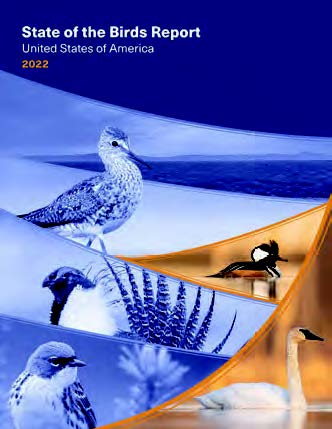Outdoor America 2022 Issue 4
Threats to bird species come in many forms, and loss of habitat is a huge factor.
In October, the North American Bird Conservation Initiative, a coalition of government agencies and nonprofits, issued its “State of the Birds 2022 Report,” which noted that bird populations are falling in nearly every type of habitat. (Visit
stateofthebirds.org/2022.)

The report found that more than half of America’s bird species are declining in nearly all types of habitat.
Grassland birds are among the fastest declining, suffering a 34 percent loss since 1970. The problem is acute in states where grasslands have been developed or converted to agriculture, like Nebraska and Iowa, and in places where trees have encroached
and reduced that historic grass habitat.
Seventy species have recently reached a perilous “tipping point,” meaning each has lost 50 percent or more of its population over the past 50 years and may lose half of what remains in the next 50 years if nothing changes. Birds that have
reached that tipping point include the rufous hummingbird, the golden-winged warbler and the black-footed albatross.
Wetland-dependent birds provide one exception to this downward trend. Waterbirds and ducks have increased by 18 and 34 percent respectively since 1970, partly because of concerted efforts and funding over many decades to preserve wetlands – habitat
that waterfowl depend on.
A report published in Science magazine in 2019 reported that the U.S. and Canada have lost three billion breeding birds since 1970, representing about one-quarter of our bird population. (The breeding bird population estimates the number of individuals
involved in breeding behavior for a given location and time period, typically nesting season.)
THESE BIRD POPULATIONS HAVE PLUMMETED
Many species have lost half their populations in recent decades. Here is a partial listing of birds from across the U.S. that were once much more common. See the full list at: stateofthebirds.org/2022.
- Bobolink
- Chimney swift
- Eastern whip-poor-will
- Evening grosbeak
- Golden-winged warbler
- Greater sage grouse
- Hudsonian godwit
- Least tern
- Pinyon jay
- Red-headed woodpecker
- Rufous hummingbird
- Saltmarsh sparrow
- Snowy owl
- Western grebe
- Wood thrush
- Yellow-billed loon
How We Can Help
One of the policy tools that will help reverse declining bird populations is the Recovering America’s Wildlife Act. Most of the 70 tipping-point species have been identified as “species of greatest conservation need” in state wildlife
action plans, and they would be prioritized for conservation through Recovering America’s Wildlife Act funding.
Forest restoration efforts in the eastern U.S. have contributed to stabilization of many other bird populations which had also suffered great losses since 1970. Two birds in particular are showing signs of recovery – the cerulean warbler and the
wood thrush.
Cats and dogs that roam freely outdoors also take a severe toll on birds. Nature Communications published a paper in 2013 that estimated between
1.3 and 4 billion birds are killed each year in the U.S. by domestic cats, including feral or un-owned cats. The study also found that cats kill between 6.3 and 22.3 billion mammals in the U.S. Off-leash dogs disturb nesting for shorebirds, game birds
and others, like the forest-dwelling whip-poor-will.
Year-round, cats should remain indoors and dogs should be kept on a leash during nesting season.
Top photo: Less common today, the rufous hummingbird has lost half of its population in recent decades. Credit: Aidan Brubaker.